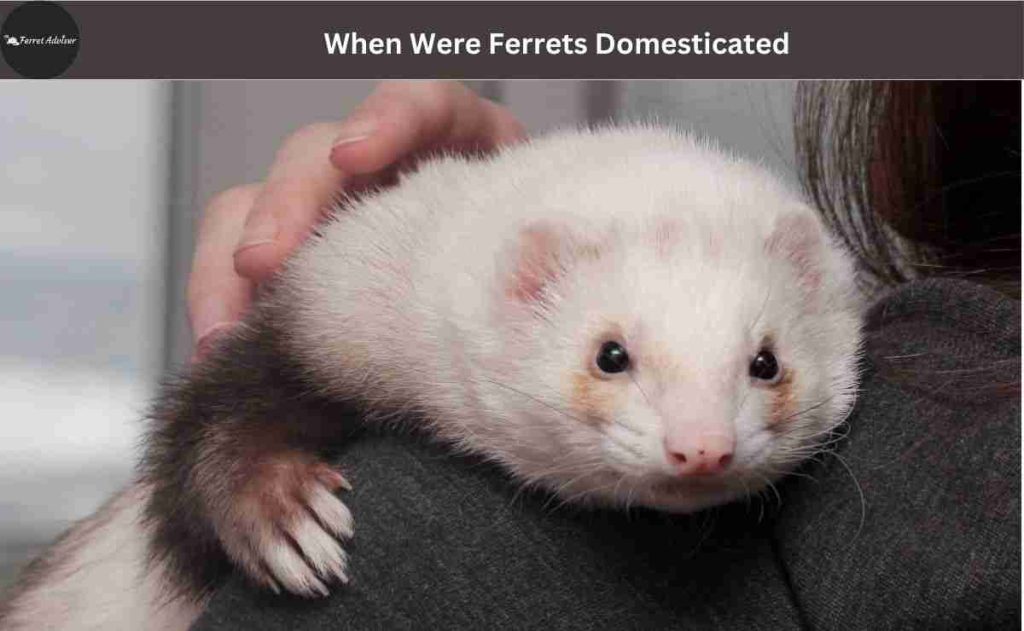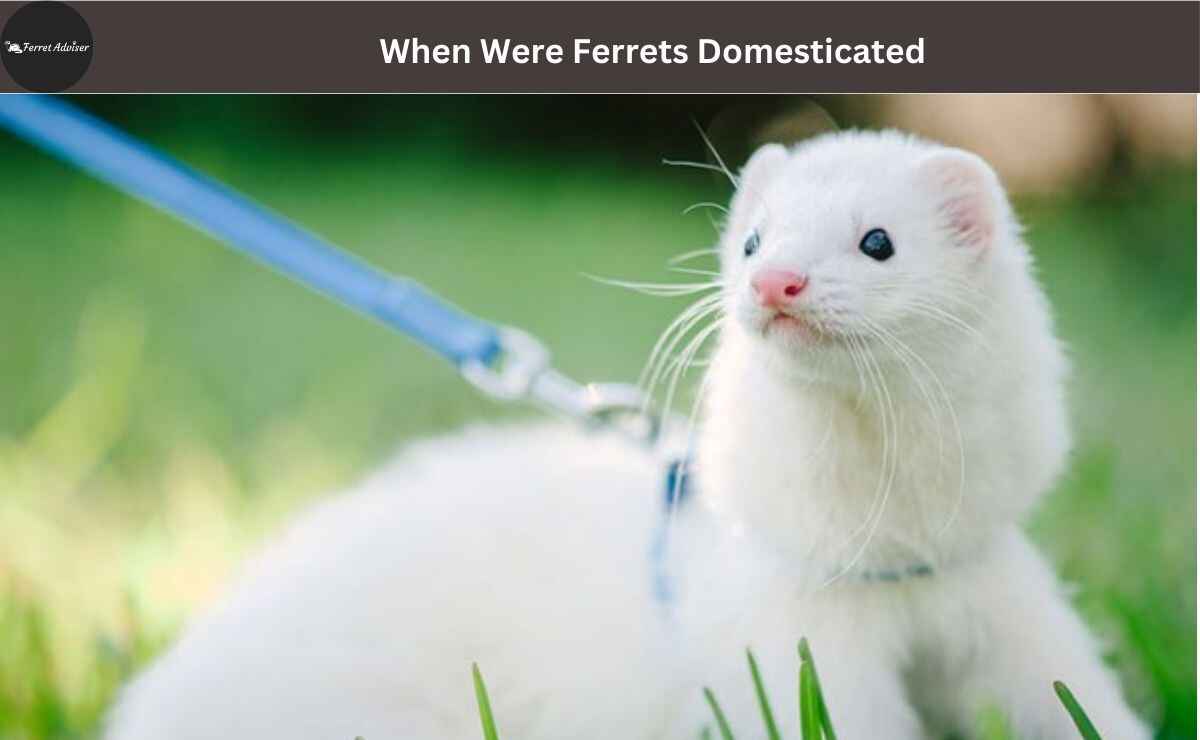Ferrets are small and adorable creatures that are famous as pets around the world. But do you ever know when were ferrets domesticated?
Ferrets have a long history of domestication, dating back thousands of years. The exact timeline of when ferrets were first domesticated is not known with certainty, but evidence suggests that it occurred as early as 2,500 years ago. However, you can explore more about ferrets in this post.
When Were Ferrets Domesticated?

The ferret belongs to the family Mustelidae and is likely a domesticated version of the wild European polecat (Mustela putorius). This is supported by the ferret’s capability to interbreed with European polecats, resulting in hybrid offspring.
The domestication of ferrets has likely occurred over time, with humans selectively breeding them for specific traits. This close relationship between ferrets and European polecats highlights their shared ancestry and the impact of human influence on their development.
According to the analysis, ferrets are domesticated around 2500 years ago. The ancient Egyptians were among the early civilizations known to have domesticated ferrets. They utilized ferrets for hunting and pest control. Ferrets were highly valued for their ability to catch rats and other small mammals that posed a threat to crops and food stores.
In Europe, ferret domestication became more widespread during the Middle Ages. They were used for hunting rabbits, which were a valuable source of food and fur. They were also used for rodent control in homes, barns, and other structures.
Keeping ferrets as pets was popularized in the 18th and 19th centuries. Ferrets were valued for their playful nature and ability to form bonds with humans. They were commonly kept as pets in households, particularly among the upper classes.
Today, ferrets are popular pets worldwide and are bred specifically for domestication. Their domestication has led to the development of various color variations and domesticated behaviors. Despite their long history of domestication, ferrets still retain some of their wild instincts, making them unique and fascinating companions.
Where Are Ferrets Native To?
Domestic ferrets, the cute pets we have today, come from wild European polecats that lived in Europe a long time ago. But, unlike our friendly pet ferrets, wild polecats are not as social. There are differences.
Now, the main difference between our pet ferrets and wild polecats are that ferrets have a smaller brain, a slightly different skull shape, move more slowly, and don’t use their scent glands as much. These changes happened over time as humans took care of and bred ferrets to be our companions.
Ferrets are native to several regions around the world, including Europe, North Africa, and parts of Asia.
In Europe, ferrets were first domesticated in ancient Greece. They were prized for their agility and ability to flush out animals from their burrows. Ferrets were later introduced to other parts of Europe, including the British Isles, where they became popular for their hunting abilities.
In North Africa, ferrets were also used for hunting, particularly in Algeria and Morocco. They were valued for their ability to chase and catch small prey in desert environments.
In Asia, ferrets are native to regions such as China, Mongolia, and Siberia. They were used by the Mongols for hunting. Ferrets were also kept as pets in some Asian cultures, with China being one of the major proponents of ferret domestication.
Were Ferrets Ever Wild?
Ferrets were domesticated members of the Mustelidae family which are not typically found in the wild today. However, their ancestors can be traced back to the European polecat, which is a wild species native to Europe. The European polecat is known to have existed in the wild for thousands of years.
Ferrets were first domesticated by humans over 2,500 years ago for hunting purposes. While ferrets are now primarily found in domesticated settings, there are still some populations of European polecats that exist in the wild.
These wild populations are typically found in rural areas, and there have been instances where domesticated ferrets have escaped and bred with these wild polecats, resulting in hybrid populations.
Ferrets are not currently considered a wild species, but their ancestors, the European polecats, were once wild and continue to exist in the wild today.
Purpose of Domesticating Ferrets
Ferrets have long been utilized by humans for various practical purposes. One primary reason for domesticating ferrets is their exceptional hunting abilities. The small carnivores possess a natural tendency to hunt and have proven extremely effective at catching small game like rabbits and mice.
Another purpose of domestication is their suitability as pets. Ferrets are known for their playful and curious nature, making them engaging companions for individuals or families.
They can be trained to use a litter box and perform various tricks, adding to their appeal as pets. Moreover, their size and relatively low maintenance make them suitable for urban living conditions.
Furthermore, ferrets are frequently employed for scientific research, particularly in the field of medical studies. Due to their physiological similarities to humans, ferrets are often used for research on respiratory illnesses such as influenza. Their use in these studies has helped advance our understanding of such diseases and develop effective treatments.
Overall, the domestication of ferrets serves multiple purposes.
Ferrets vs. Polecats
Ferrets and polecats may look similar at first glance, but there are actually some differences between the two.
Both ferrets and polecats belong to the Mustelidae family, which also includes otters, weasels, and badgers. However, while they share a common ancestor, they have developed distinct characteristics over time.
- Size
One key difference between ferrets and polecats is their size. Ferrets are typically smaller than polecats, measuring around 20 inches in length and weighing between 1 and 5 pounds.
Polecats, on the other hand, are larger, with an average length of 30 inches and weighing between 2 and 6 pounds.
- Appearance
Ferrets have been selectively bred for domestication and have a range of coat colors, including albino, sable, and silver.
Polecats have a wilder appearance with a brown or dark fur coat that has distinctive white markings on their face, throat, and chest.
- Behavior
Ferrets have been domesticated for centuries and are commonly kept as pets. They have a playful and curious nature, and with proper training, can be taught tricks and respond to commands.
Polecats are wild animals and have a more solitary and elusive nature. They are known for their hunting skills and are typically found in woodland areas.
- Diet
Ferrets are carnivores and primarily eat meat-based diets. Polecats, as wild animals, have a wider dietary range and will eat a variety of prey including small mammals, birds, and fish.
Conclusion
The history of ferret domestication is interesting and full of rich developments. Over the 2,500 years since their domestication, a lot has happened. What’s particularly impressive is how they evolved from being simple hunters to serving as cable transporters and eventually becoming our beloved pets.
The transition from working animals to beloved pets further emphasizes the deep connection between ferrets and humans. Throughout history, ferrets have remained cherished pets due to their historical utility as well as their playful and affectionate nature.
The journey of ferrets showcases their incredible adaptability and the close bond that has formed between them and humans over the years.
